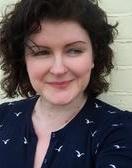I wonder if it is wrong that I chose today's subject because of her name?
It's all go today as we are having our Christmas Day tomorrow with the family, so I am busy making croissants (family tradition), peeling sprouts and making a trifle whilst trying to remember what I could have possibly forgotten, In the meantime, for the penultimate day of Blogvent I have the charmingly named Alma Gogin for company...
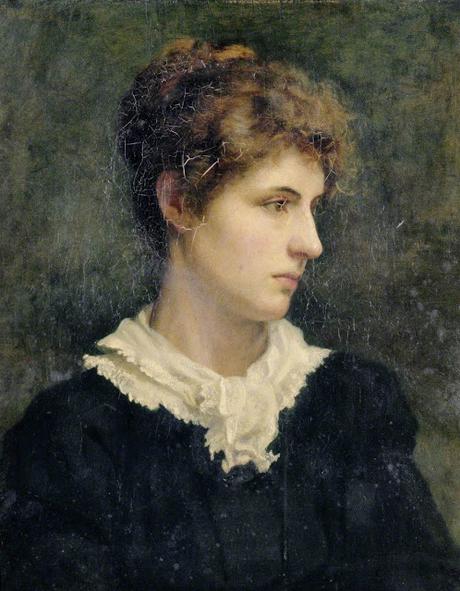
Alma Gogin (undated) Charles Gogin
I have found another artist-wife-of-an-artist, however, before she was Alma Gogin, she was Susan Alma Broadbridge, born on 1st October 1854 to Edward (1830-1911) and Mary (1828-1906) in Brighton. Edward was a furniture dealer and upholsterer (like Averil Burleigh's Dad and my Uncle Chub) with the family living above the (quite large and pleasant) shop in East Street in Brighton, close to the sea. Her mother was a milliner and the family seem very comfortably off, Edward serving as a local Councillor, and the family was well-known. Alma was the second of four siblings - her older sister Kate (1853-1927) and younger brothers Edward (1863-1898) and Walter (1871-1946). By 1871, the family had moved up the road to Queen's Road and were living at 111 Queen's Road, now known as Sundial House. There was definitely a moment when she stopped being Susan and started being Alma but that seems to have happened at different times for her work life and census records. I'll just make it simple and call her Alma, as she wanted.
At some point in the 1870s and 80s, Alma went to Paris to study art with Gustave Boulanger (1824-1888) and Julian Joseph Lefebvre (1836-1911) at the Academie Julian, and she appears to be absent from home during the 1881 census so that may well have coincided with this period. Alma's work was first seen in her native Brighton in the Corporation Gallery's 1880 exhibition of oil paintings. Of the around 700 works, a fifth of them were by local artists including Alma. Her work also appeared at the Manchester Art Gallery exhibition of 1884 where the gallery bought her piece Cherries for £6 6s for the collection.
Her break into the Royal Academy came in 1886 with An Unequal Match, which didn't make much impact in the press, but she also had two other exhibitions which at least got her mentioned. The November exhibition of the Nineteenth Century Art Society in Conduit Street contained Alma's piece Day Dreams described by the London Evening Standard as 'a very well dressed young lady, sitting in a very pretty chair - [it] invites attention by harmonious colours and dignity of treatment.' She also appeared in Brighton's Corporation Art Gallery 12th annual exhibition of modern pictures in oil where, according to the Brighton Herald she 'showed some good work'.
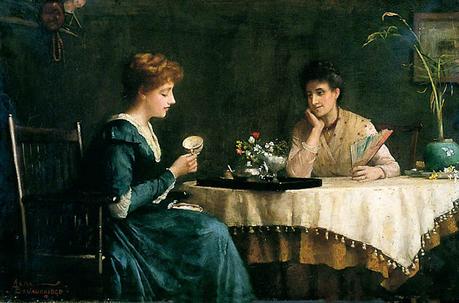
"So for good or ill in leaves of tea / Do maidens find their fortune told" (1887)
By 1887's Royal Academy, Alma had moved to Warwick Studios in Hampstead and her painting that year was "So for good or ill in leaves of tea / Do maidens find their fortune told" which is also known by the far duller title 'Tea leaves'. I love this painting, even down to the tassels on the tablecloth. I'd love to see it and see if we can work out what the fortune will be - there are some flowers and a fan, all of which hold messages, for example the open fan in the left hand means 'come and talk to me,' which might hint that she is hoping for someone she loves to come and tell her that they love her too. Next to her seems to be a bunch of those tiny daffodils which symbolise forgiveness, and the lily next to her has died (is that a Madonna lily with dead flowers?). I'm building a whole scenario of someone dying and she's learning to forgive them because she's met a good looking bloke who will look after her daffodils for her. I love narrative art so much.
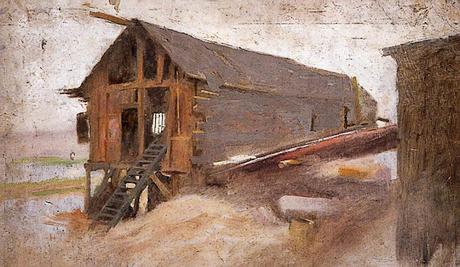
Shipyards Studio, Shoreham (1889)
In 1888, Alma started to offer lessons in the Brighton Gazette - 'Miss Alma Broadbridge, exhibitor at the Royal Academy and pupil of Mons. Lefbre [sic] and Mons. Boulanger (members of the Institute of France) has established a CLASS for the study of DRAWING and PAINTING in oil and water-colour. Private lessons and schools by arrangement - 60 Brunswick Road, Hove.' When I read things like that, the capital letters end up being shouted for effect. She appeared to have moved back down to Brighton, backed up by her 1889 Royal Academy entries, a three-quarter portrait of her mother and another of a woman after a ball. The Brighton Gazette reported 'the young artist may consider herself very fortunate in getting two pictures hung, especially as they were portraits' which is an interesting attitude - I assumed portraits would get less attention in the press unless the person was well known or exceptionally pretty but I didn't know that portraits were harder to get into the RA, or at least perceived to be.
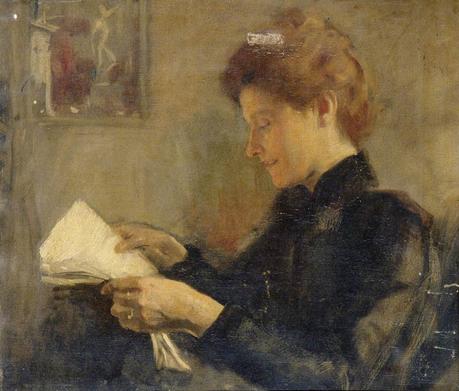
Alma Reading (1888) Charles Gogin
There was no exhibition for Alma in 1890, but in 1891 she was back at the RA with Confirmation Day. She was the last of the children living at home according to the census that year: Kate was married to Charles Hudson and living in Cuckfield in Sussex, Edward was married to Clara and living in Brighton, Walter away from home and due to be married to Louise. Alma married in 1894 to fellow artist Charles Gogin (1844-1931). A decade older, Charles was the son of a commercial clerk from France who died in the mid 1860s. Before his father's death Charles too was heading for Clerk Life, whilst his sister Cecilia was training to be an artist. After Claude Gogin died, Charles trained to be a painter, hence he and Alma were at a similar point in their careers, although Charles exhibited a little earlier.
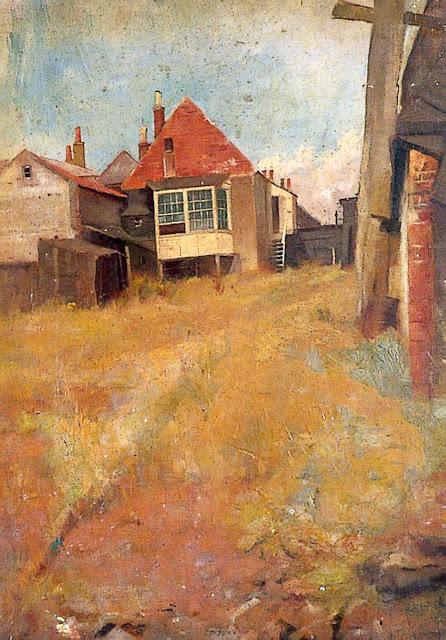
Our Studio in Shoreham (1900)
The Royal Academy just after the Gogin wedding was the last one Alma exhibited as 'Broadbridge'. Her piece "Please, May I Come In?" received no press coverage or any illustration in the Royal Academy catalog. That's true of all her work, and to be fair, Charles isn't exactly overly illustrated on that front either. Alma returned in 1895 with Little Sunshine and the couple had moved to Shoreham (living there around the same time as Annie Miller, Pre-Raphaelite model).
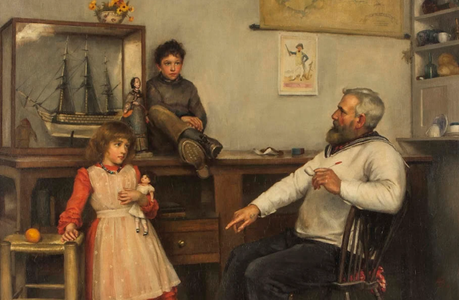
The Captain's Story (1895)
She also showed The Captain's Story in 1895 which proved very popular. The Manchester Evening News reported 'The old tar is telling his stirring tale to the children, and the pose and intense expression of the three are admirable.' Stratford upon Avon Herald felt the work illustrated 'her capacity of subject.' It is a beautiful picture, a bit like something painted by George Dunlop Leslie. She scored again in 1898 with "What Shall I Say?" a painting of a girl sitting at a spinning wheel reading a letter, which was hung in a favourable position. She also appeared in the Autumn exhibition at the Dudley Art Gallery in September.
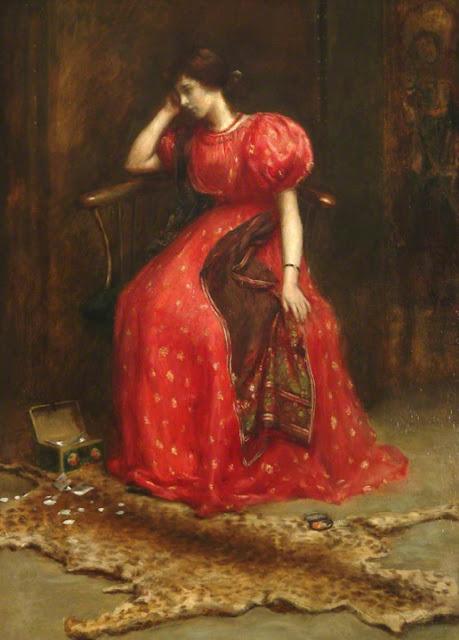
Regrets (undated)
By 1901, Alma and Charles were living in Compton Avenue in Brighton, which are tall white houses that are worth over a million. Both Alma and Charles are listed as artists and art teachers on the census and they have a servant. As far as I can see, Alma didn't exhibit on such a grand scale after this point. Charles had painted the portrait of Samuel Butler, novelist, and acted as his artistic consultant; on Butler's death in 1902, the author left Charles a life annuity of £100 which would pass to Alma on Charles's death.
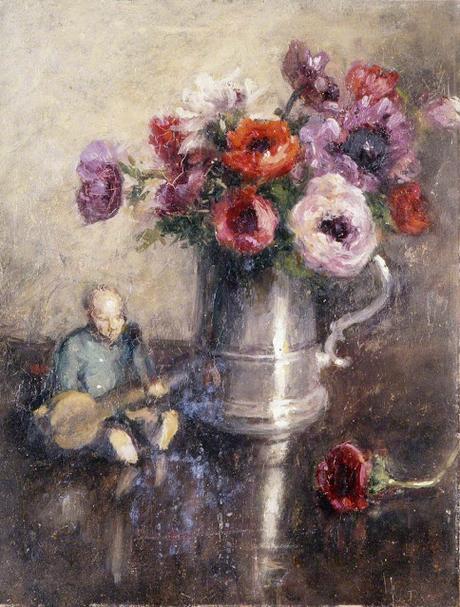
Anemones (20th century)
In the 1911 census, again the Gogins are both artists and art teachers at Clarence Square. In fact, their life seems quite quiet and uneventful other than a move from Brighton to Reigate in Surrey until Charles's death in 1931, then Alma's profile rises rapidly once more. Charles died in the January of that year and by the March, possibly spurred by his death, she was holding an exhibition at their home at 95 Station Road in Reigate. The Surrey Mirror reported that Alma was 'an artist of considerable repute' and the exhibition 'promises to afford much pleasure and interest ... students of art, particularly, could spend many useful moments glancing at the fine collection of flower studies - in oil and water-colour - which constitute one of the features of a notably varied show.' She also gave the Borough two paintings by Charles - Sea Poppies and Ypres Castle, Rye - and one of her own, Regrets.
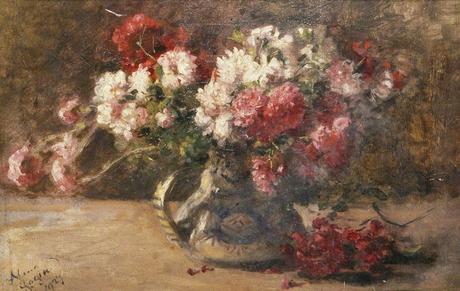
Chrysanthemums (1927)
By the 1939 register, Alma had moved to 92 Blackborough Road in Reigate, listed merely as retired, a widow with a maid. In 1945, Alma invited the Haywoods Heath librarian (the town not being very far from Reigate) to view her collection with the idea to bequeath several of her and her husband's paintings to the new Haywoods Heath Museum. She died three years later, noted by the West Sussex Gazette - 'By the death of Mrs Alma Gogin (92) of Hatchlands Road, Redhill, an interesting link with Victorian art and letters has been severed. Mrs Gogin was the widow of Charles Gogin, landscape and portrait painter ... Mrs Gogin was also a gifted artist, who specialised in flower studies and was a discriminating collector of objets d'art.'
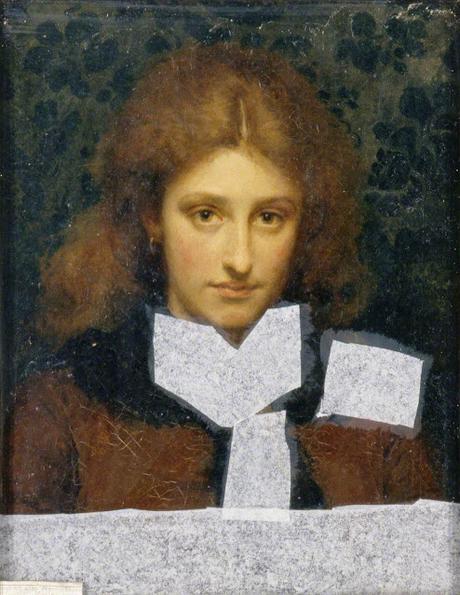
Alma (1890s) Charles Gogin
I think we have a rare moment where both Alma and her husband have been neglected. Look at the tissue on the portrait of Alma above, stabilising the the paint surface in need of conservation. The couple are both talented artists and need our love. What I find interesting about Alma is that although she did a fair amount of flower painting, she found her fame with narrative pieces, yet she is repeatedly called a flower painter. Here is the continued down-playing of women's art, still-life scoring far below other categories in the artistic hierarchy. As we draw to the end of Blogvent, there are patterns of how these women are forgotten, are diminished, and tomorrow we will examine the scale of the problem then and now, and work out how we will fix it.
